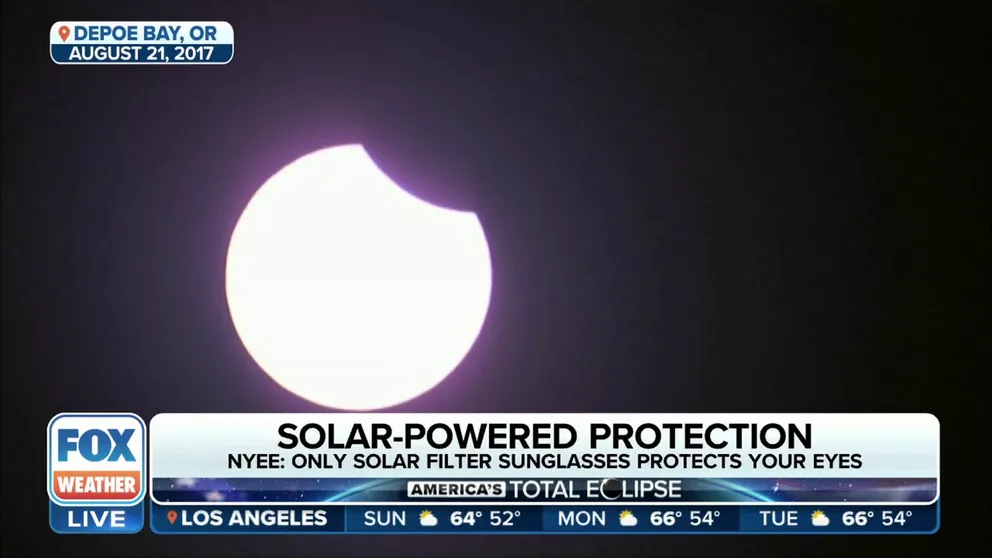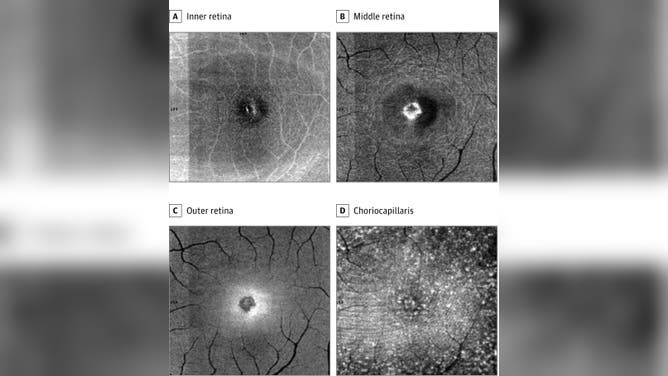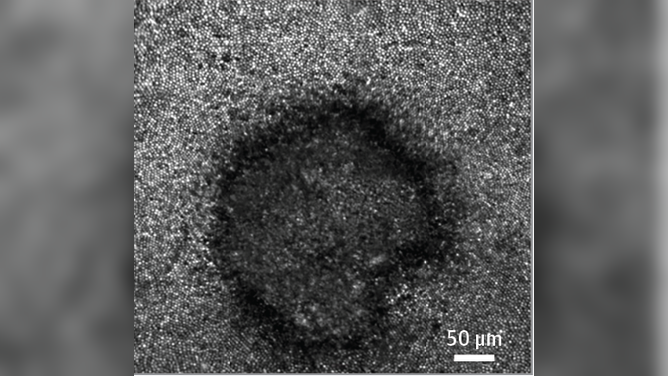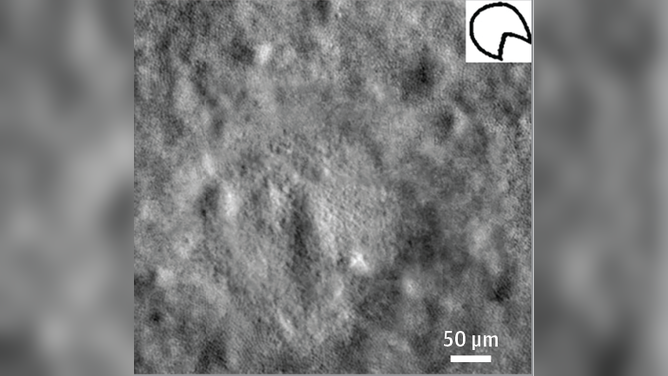Fake safety glasses left woman with permanent eye damage during 2017 solar eclipse, doctor says
The young woman's vision was 20/20 in the right eye and 20/25 in the left before the eclipse. Within four hours of looking at the sun, she said her vision was blurry and distorted in both eyes, and the only color she could see was black.
Eye protection is a must when it comes to viewing April's total solar eclipse
If you’re among the millions of people who will get the chance to witness April’s total solar eclipse, you’re going to want to use eye protection. Vitreoretinal surgeon at New York Eye and Ear Infirmary of Mount Sinai Dr. Avnish Deobhakta joined FOX Weather on Sunday to explain the dangers of viewing the eclipse without proper eye protection.
Glimpsing the solar eclipse for just 20 seconds caused permanent eye damage to one New Yorker during the last total solar eclipse in 2017, and she thought she was wearing safety glasses.
A doctor looked closer at the rare condition called solar retinopathy with photochemical burns. The condition has no known treatment.
"We looked directly at the specialized cells of the retina that receive the light … Those cells are the ones that are the most affected when the eclipse actually shines its rays when you're looking at it," Dr. Avnish Deobhakta, vitreoretinal surgeon of the Ear and Eye Infirmary of Mount Sinai. "And so, in this case, with this patient, we were able to image how the rays of the sun actually created a burn in the shape of an eclipse directly onto the retina. So it was actually in the shape of the eclipse that you would have seen in the sky in New York City."
HOW TO SAFELY WATCH A SOLAR ECLIPSE
Not a myth or wives' tale
It is neither a wives' tale nor a mom-myth. Here is real evidence of the harm of looking directly at the sun, even for just seconds. Ophthalmologists fear a repeat during the Great American Solar Eclipse on April 8, 2024.
"The patient actually looked at the sun with glasses that she thought were protective, and in that case, they weren't protective," Deobhakta said. "She ended up having damage to the retina, which is like the camera film of the eye, and unfortunately, we're not able to fix that kind of damage."
The young woman's vision was 20/20 in the right eye and 20/25 in the left before the eclipse. Within four hours of looking at the sun, she said her vision was blurry and distorted in both eyes, and the only color she could see was black.
WHO WILL BE ABLE TO SEE THE APRIL 2024 TOTAL SOLAR ECLIPSE?

File: The sun's corona is visible as the moon obscures the sun during the Great American Solar Eclipse at Madras High School in Madras, Oregon, on Monday, August 21, 2017.
(Carlos Avila Gonzalez/The San Francisco Chronicle / Getty Images)
The solar retinopathy actually permanently damaged the photoreceptors, cells that take in light. The damage was crescent-shaped, the exact shape of the visible area of the sun during the eclipse.
Permanent damage takes just seconds
Usually, the sun is too bright and too difficult to look directly into. Even without looking at the sun, just being exposed to the light, especially to the blue and ultraviolet portions, can cause eye disease that can lead to blindness.
"Children are especially at risk, as young eyes transmit more light through to the retina than adult eyes," warns the Australian Radiation Protection and Nuclear Safety Agency online. "This makes children’s eyes more susceptible to damage from intense light."
WHAT YOU NEED TO KNOW ABOUT APRIL'S TOTAL SOLAR ECLIPSE
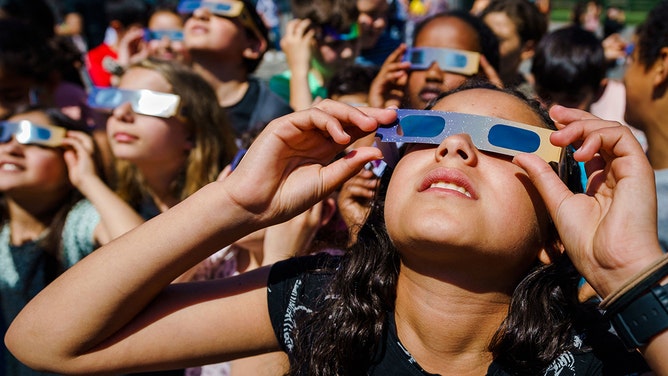
Pupils, wearing protective glasses, look at the partial solar eclipse in Schiedam on June 10, 2021.
(MARCO DE SWART/ANP/AFP / Getty Images)
UV rays damage skin, but since the retinas, parts of the eyes responsible for vision, don't have pain receptors, we have no idea we are damaging the eyes.
The solar eclipse cuts down on so much of the visible light that we can look directly at the sun. Unfortunately, timing the eclipse is tough, and the rim of sunlight can peek around, warns PreventBlindness.org.
Even looking at your phone's screen can be dangerous.
"If you're looking through the screen, only, you're actually somewhat safe," said Deobhakta. "The problem is, as we've all been to concerts, when you try to lift your phone up to the sky or toward the concert, you're going to peak around, or you have that urge to peek around, and that's where you're suddenly looking at the eclipse itself, without any glasses on that are protective."
Burning the retina can lead to loss of vision, distorted vision or altered colored vision.
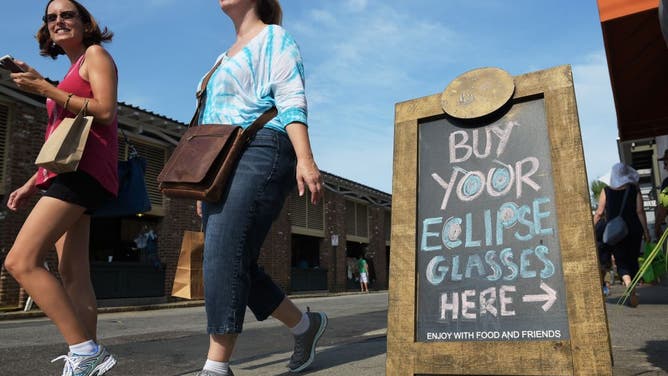
A board advertises eclipse glasses for sale at a restaurant ahead of the total solar eclipse in Charleston, South Carolina, on August 20, 2017.
(MANDEL NGAN/AFP via Getty Images / Getty Images)
Officially rated safety glasses
The only safe glasses and camera filters for looking at the sun are rated ISO 12312-2, according to Deobhakta.
"Be careful of counterfeits often sold online and seek out approved vendors listed by the American Astronomical Society," stated the doctor in a press release.
Deobhakta offered a few more tips for viewing the eclipse safely:
- Do not use binoculars or special lenses that magnify the eclipse. These can focus the sun’s rays into the retina and cause damage.
- It is safe to properly use a pinhole camera to view the eclipse.
- If you record the eclipse on your phone, do not look at the screen while it’s recording and watch the video later.
Many will want to see the rare sight. According to the American Astronomical Society, any given spot on the planet sees temporary darkness from the moon’s shadow on average once every 400 years. The next total solar eclipse over the U.S. will be Aug. 23, 2044.
